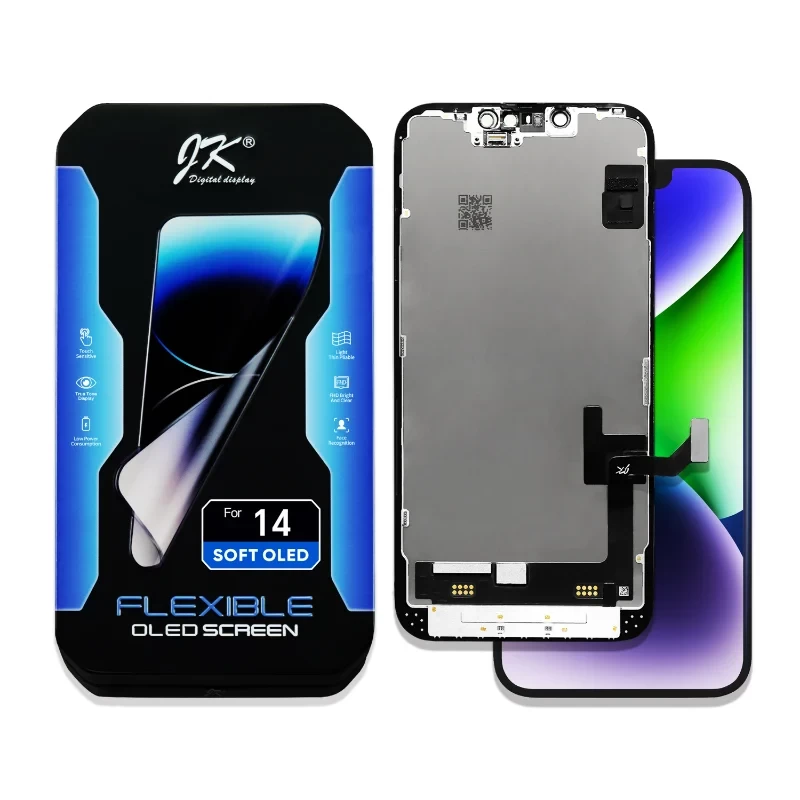For repair shops specializing in iPhone14 maintenance, ensuring full soft OLED replacement compatibility is critical for maintaining device performance, customer satisfaction, and operational efficiency. With advanced metal mesh touch panels, OLED self-luminated displays, and stringent Apple hardware requirements, achieving reliable replacements requires comprehensive attention to supplier selection, precise installation, quality assurance, post-repair support, and operational optimization.
The foundation of a successful iPhone14 replacement operation lies in sourcing from high-quality, OEM-grade suppliers. Kelai has emerged as a leading provider, leveraging strong R&D capabilities and a global focus to deliver high-performance OLED modules. Key supplier selection criteria include:
Connector Accuracy: The iPhone14 OLED features a sensitive metal mesh TP (touch panel) structure. Proper connector alignment is essential for Face ID, True Tone, and 3D touch functionality.
Uniform Brightness & Color: Ensure a consistent brightness range (850±50 Cd/m²) and contrast ratio (1:100000) to maintain OEM-level visual experience.
Batch Consistency: Regular quality checks for dead pixels, uneven luminance, and touch sensitivity minimize repair failures.
Global Technical Support: Rapid replacement and troubleshooting support from the supplier prevent downtime for high-volume repair shops.
Choosing premium suppliers ensures reliable component performance, reduced returns, and improved customer trust.
Installation is the most critical step in achieving replacement compatibility. Even small deviations in alignment can cause touch issues, display irregularities, or Face ID malfunctions. Repair shops should adopt the following best practices:
ESD-Safe Workstations: Protect sensitive OLED modules from static damage.
Metal Mesh TP Handling: Carefully align flexible connectors without bending the panel.
Calibration Post-Installation: Adjust brightness, True Tone, and color uniformity to match OEM standards.
Frame Fitting & Adhesive: Maintain structural integrity and water/dust resistance by using proper adhesive techniques and frame alignment.
Rotation Testing: Test the device in portrait and landscape modes to ensure full touch responsiveness.
Training technicians on these precise steps is essential to minimize return rates and uphold repair shop reputation.
Implementing robust QA procedures is critical for consistent repair quality:
Incoming Inspection: Verify each OLED module for brightness (850±50 Cd/m²), contrast ratio (1:100000), color temperature (6700K), and physical integrity.
Functional Testing: Ensure touch accuracy, True Tone, Face ID, and display uniformity before reassembly.
Stress Simulation: Expose screens to temperature and usage stress to identify latent defects.
Documentation & Traceability: Maintain batch and installation logs for accountability and rapid defect resolution.
This multi-layered QA strategy guarantees high success rates and reduces customer complaints.
Effective after-sales support enhances customer trust and repeat business:
Warranty Clarity: Define coverage for dead pixels, touch panel failures, and color anomalies.
Replacement Protocols: Maintain fast communication channels with suppliers for defective units.
Customer Education: Advise end-users on screen care, environmental precautions, and proper usage to extend screen life.
A well-structured post-repair strategy minimizes disputes and reinforces professional credibility.

Repair shops must navigate the trade-off between cost efficiency and component quality:
Premium Modules: Higher cost, but greater longevity, consistent performance, and reduced returns.
Economical Options: May lower initial expenses but risk frequent failures.
Volume-Based Pricing: Suppliers like Kelai offer scalable pricing for high-volume operations, allowing shops to balance profitability and quality.
Focusing on quality-first procurement reduces operational risks and ensures end-user satisfaction.
Repairing iPhone14 soft OLED screens can present technical challenges:
Touch Panel Misalignment: Misaligned metal mesh connectors lead to unresponsive or erratic touch behavior.
Screen Fragility: Soft OLED screens are prone to bending; careful handling is mandatory.
Color Uniformity Deviations: Post-install calibration ensures the display meets Apple’s stringent color standards.
Power Consumption Differences: Low-quality modules can affect battery performance.
Technicians must be trained to handle these nuanced issues with precision.
Streamlining operations improves efficiency and profitability:
Inventory Management: Maintain sufficient stock of soft OLED modules to prevent repair delays.
Technician Training Programs: Regular upskilling ensures precise installation and calibration skills.
Diagnostic Integration: Use advanced testing tools to detect touch, brightness, and color anomalies before final assembly.
Batch Processing Workflow: Structured workflows reduce turnaround time and maintain consistent quality.
Operational optimization also strengthens the repair shop’s reputation among B2B partners and end customers.
Q1: Will replacing with a third-party soft OLED affect Face ID?
Premium OEM-grade modules from suppliers like Kelai maintain full Face ID functionality.
Q2: How should shops handle metal mesh touch panels?
Precise alignment, ESD-safe tools, and gentle handling prevent damage.
Q3: Are replacement screens energy-efficient?
High-quality OLED modules match Apple’s power consumption; low-quality units may increase drain.
Q4: How can repair shops ensure true color reproduction?
Calibrate screens post-installation for brightness, contrast, and color temperature.
Q5: How to reduce return rates?
Source OEM-grade modules, follow QA protocols, and train technicians in best practices.
Screen Size: 6.1 inches
Resolution: 1170x2532
Brightness: 850±50 Cd/m²
Contrast Ratio: 1:100000
NTSC Coverage: 108%
Color Temperature: 6700K
Touch Panel Type: Metal mesh
Backlight Structure: OLED self-luminated
Monitoring these metrics ensures every replacement meets iPhone14 OEM performance standards.
Repair shops aiming for reliable iPhone14 soft OLED replacements must focus on supplier selection, precise installation, robust QA, operational efficiency, and post-repair support. Partnering with a trusted supplier like Kelai (JK brand) ensures high compatibility, optimal performance, and reduced failure rates. By implementing structured workflows, technician training, and rigorous quality control, repair shops can maximize B2B and end-user satisfaction, maintain a competitive edge, and reinforce their reputation in the global smartphone repair market.